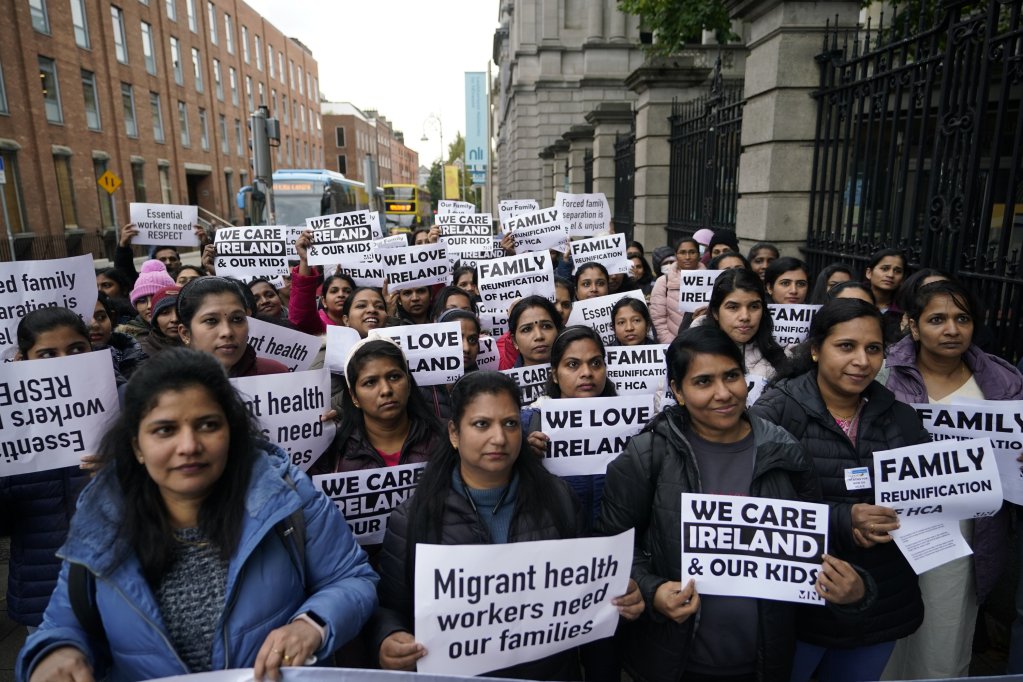The International Labor Organization says that migrant workers are playing an increasingly important role in European labor markets. In the last decade, the proportion of migrant workers has also slightly increased.
Globally, migrant workers make up 4.7 percent of the labor force, but in Europe, the percentage is even greater, and rising. "International migrants are a vital force in the global labor market," states the International Labor Organization (ILO) in its latest report published on December 16.
In 2013, the proportion of migrant workers employed in Europe stood at 22.5 percent. Nearly a decade later, in 2022, that figure had risen slightly to 23.3 percent. Ageing populations in regions like Europe, as well as North America and some Arab countries, mean that there will be an ever-increasing need for migrant workers to keep the economy running and keep paying in to the pension systems in countries with welfare states.

In 2022, the number of international migrants globally reached nearly 285 million people. Of these, nearly 168 million were actively contributing to the labor force. Most live in high-income countries.
A recent study by the Bertelsmann Foundation, published at the end of November, suggests that Germany will need around 288,000 migrant workers yearly until 2040 to sustain the economy and pay for the increasing number of people who are pensioned.
Currently, Germany is falling a long way short of this goal. In the first half of 2024, it issued around 80,000 employment visas. More than half of those were to skilled workers.
The Netherlands is also offering tax breaks for skilled migrants, to try to attract more people to the country.
Read AlsoAs Europe needs workers, Syrians face push to return
Migrants are needed
Migrants are needed both to take the jobs of people leaving the labor market through retirement, as well as increasingly to work as carers for the elderly people who are living longer, and sometimes needing years, if not decades, of specialized care.
About 28.8 percent of migrant women are employed in the care sector and domestic work, according to the ILO, and about 12.4 percent of migrant men work in the same sector.
The ILO defines as a migrant anyone who is working in a country other than the one in which they were born. This definition includes people with work visas and those working undocumented in the host countries.

A campaign in the Italian region of Sicily against the exploitation of workers estimated that in that region alone, there are around 288,000 undocumented workers. many of whom work in the agricultural sector and live in makeshift camps on or near the fields in which they work.
This year, Spain announced that it would try to combat a similar problem by legalizing around 300,000 undocumented workers a year, to allow them access to proper employment contracts, healthcare and all the other protections that should come with being employed legally.
Around two thirds of migrant workers in Europe are employed in the service industries, states the ILO. That is a greater proportion than the native population, which generally accounts for about half of all workers in the service industries.
After the service industry, migrant workers tend to be employed in industry and agriculture.
Read AlsoGerman health system would struggle without Syrian doctors
Unemployment rates
Overall, the unemployment rate among migrant workers is also slightly greater than in the native-born populations. According to the ILO, it stands at about 7.2 percent, compared with about 5.2 percent in the native populations. The reasons for this could include language barriers, unrecognized qualifications and discrimination, limited childcare options and gender-based expectations that restrict employment opportunities, particularly for women, according to the ILO.

However, in Europe, as well as the Americas, the Arab States and Central Asia, migrant men actually have lower unemployment rates than non-migrant men. Migrant women only have lower unemployment rates than non-migrant women in the Americas and the Arab States.
Despite this figure, migrants had higher labor force participation rates than non-migrants globally. "Many migrants move primarily for economic reasons, seeking better job opportunities and higher wages," stated the report.
Ensuring rights and access to decent work is not only a moral imperative but also an economic necessity
Migrant men were also more likely to be employed than migrant women. About 72.8 percent of migrant men are employed, compared with about 48.1 percent of migrant women. The lowest labor force participation rate was in North Africa, according to the ILO. Just 46.5 percent of migrants were employed in that region. This could be because that region tends to be one of transit for migrants on their way to Europe. The overall labor force proportion of migrants in the labor force in North Africa stood at 1.5 percent in 2022.
Read AlsoRising number of foreigners in Italy: 'Nearly all are employed,' says INPS
Gender differences
Around 102.7 migrant workers are men and around 64.9 million are women, the ILO said in a press release. Female migrant workers tended to be concentrated in higher income countries, where more migrant workers congregate anyway. This might be because women tend to have easier access to the labor markets in these countries, the agency said. Access to childcare facilities and policies encouraging paid work among women might also benefit migrant women in these regions.

The ILO report underlines the complexities of labor migration and the need for countries to produce targeted policies in order to support international migrants. The agency said countries should improve access to decent work opportunities and enhance the protection of migrant workers.
"Migrant workers are indispensable in addressing global labor shortages and contributing to economic growth," said ILO Director-General Gilbert F. Houngbo. "Ensuring their rights and access to decent work is not only a moral imperative but also an economic necessity."
Migration policies tend to favor skilled and experienced workers, according to the ILO. "The presence of international migrants in the labour force not only benefits the destination countries, for example by addressing skills shortages and enriching host communities, it also supports development in their home countries through remittances and newly acquired skills of returning migrants."
With dpa, EPD
